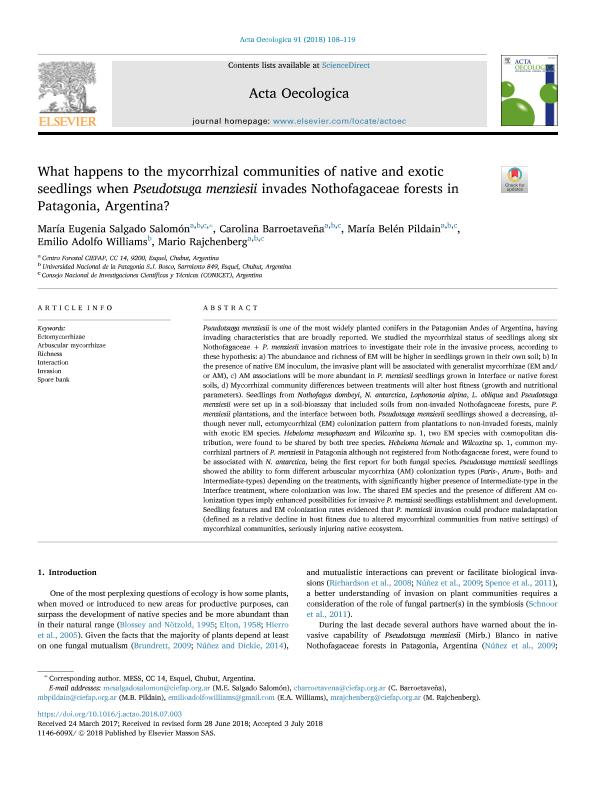Artículo
What happens to the mycorrhizal communities of native and exotic seedlings when Pseudotsuga menziesii invades Nothofagaceae forests in Patagonia, Argentina?
Salgado Salomón, María Eugenia ; Barroetaveña, Carolina
; Barroetaveña, Carolina ; Pildain, María Belén
; Pildain, María Belén ; Williams Subiza, Emilio Adolfo
; Williams Subiza, Emilio Adolfo ; Rajchenberg, Mario
; Rajchenberg, Mario
 ; Barroetaveña, Carolina
; Barroetaveña, Carolina ; Pildain, María Belén
; Pildain, María Belén ; Williams Subiza, Emilio Adolfo
; Williams Subiza, Emilio Adolfo ; Rajchenberg, Mario
; Rajchenberg, Mario
Fecha de publicación:
17/08/2018
Editorial:
Gauthier-Villars/Editions Elsevier
Revista:
Acta Oecologica
ISSN:
1146-609X
Idioma:
Inglés
Tipo de recurso:
Artículo publicado
Clasificación temática:
Resumen
Pseudotsuga menziesii is one of the most widely planted conifers in the Patagonian Andes of Argentina, having invading characteristics that are broadly reported. We studied the mycorrhizal status of seedlings along six Nothofagaceae + P. menziesii invasion matrices to investigate their role in the invasive process, according to these hypothesis: a) The abundance and richness of EM will be higher in seedlings grown in their own soil; b) In the presence of native EM inoculum, the invasive plant will be associated with generalist mycorrhizae (EM and/or AM), c) AM associations will be more abundant in P. menziesii seedlings grown in Interface or native forest soils, d) Mycorrhizal community differences between treatments will alter host fitness (growth and nutritional parameters). Seedlings from Nothofagus dombeyi, N. antarctica, Lophozonia alpina, L. obliqua and Pseudotsuga menziesii were set up in a soil-bioassay that included soils from non-invaded Nothofagaceae forests, pure P. menziesii plantations, and the interface between both. Pseudotsuga menziesii seedlings showed a decreasing, although never null, ectomycorrhizal (EM) colonization pattern from plantations to non-invaded forests, mainly with exotic EM species. Hebeloma mesophaeum and Wilcoxina sp. 1, two EM species with cosmopolitan distribution, were found to be shared by both tree species. Hebeloma hiemale and Wilcoxina sp. 1, common mycorrhizal partners of P. menziesii in Patagonia although not registered from Nothofagaceae forest, were found to be associated with N. antarctica, being the first report for both fungal species. Pseudotsuga menziesii seedlings showed the ability to form different arbuscular mycorrhiza (AM) colonization types (Paris-, Arum-, Both- and Intermediate-types) depending on the treatments, with significantly higher presence of Intermediate-type in the Interface treatment, where colonization was low. The shared EM species and the presence of different AM colonization types imply enhanced possibilities for invasive P. menziesii seedlings establishment and development. Seedling features and EM colonization rates evidenced that P. menziesii invasion could produce maladaptation (defined as a relative decline in host fitness due to altered mycorrhizal communities from native settings) of mycorrhizal communities, seriously injuring native ecosystem.
Palabras clave:
Arbuscular Mycorrhizae
,
Ectomycorrhizae
,
Interaction
,
Invasion
,
Richness
,
Spore Bank
Archivos asociados
Licencia
Identificadores
Colecciones
Articulos(CIEMEP)
Articulos de CENTRO DE INVESTIGACION ESQUEL DE MONTAÑA Y ESTEPA PATAGONICA
Articulos de CENTRO DE INVESTIGACION ESQUEL DE MONTAÑA Y ESTEPA PATAGONICA
Articulos(SEDE CENTRAL)
Articulos de SEDE CENTRAL
Articulos de SEDE CENTRAL
Citación
Salgado Salomón, María Eugenia; Barroetaveña, Carolina; Pildain, María Belén; Williams Subiza, Emilio Adolfo; Rajchenberg, Mario; What happens to the mycorrhizal communities of native and exotic seedlings when Pseudotsuga menziesii invades Nothofagaceae forests in Patagonia, Argentina?; Gauthier-Villars/Editions Elsevier; Acta Oecologica; 91; 17-8-2018; 108-119
Compartir
Altmétricas



